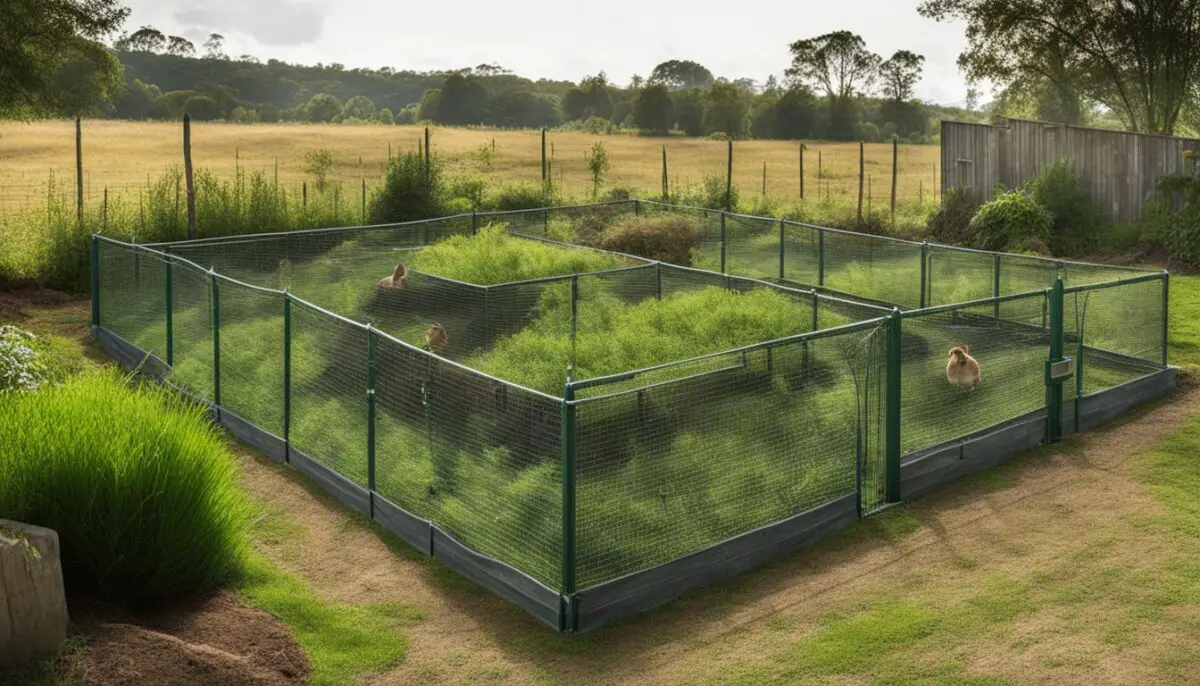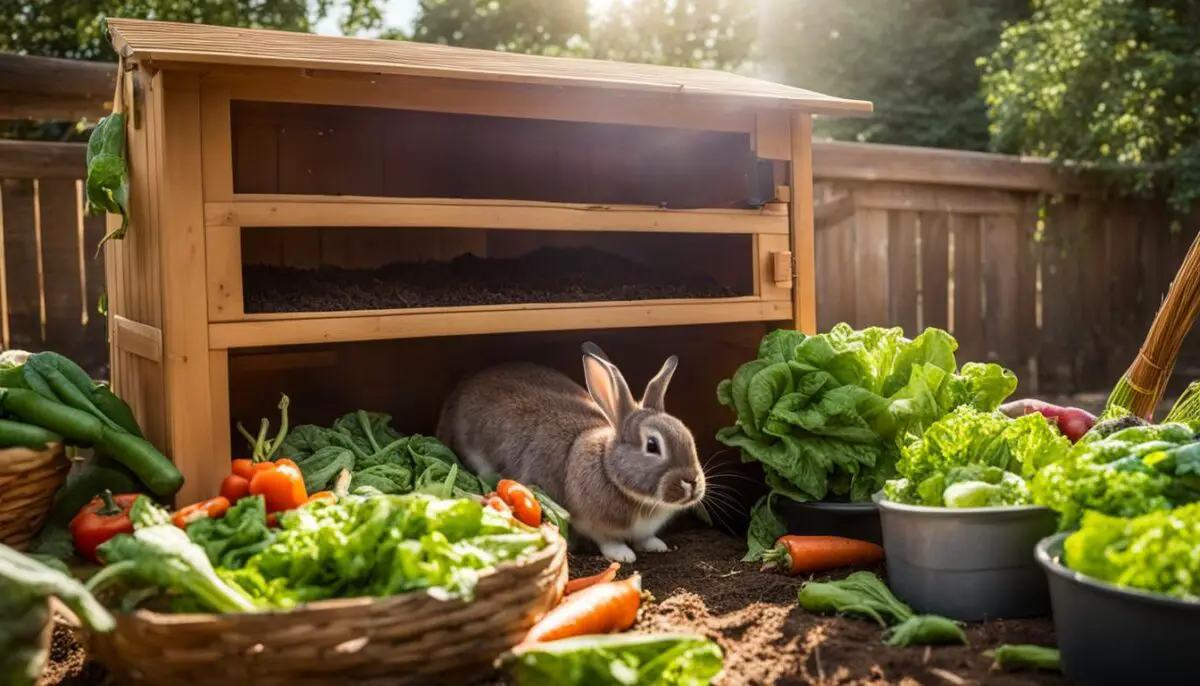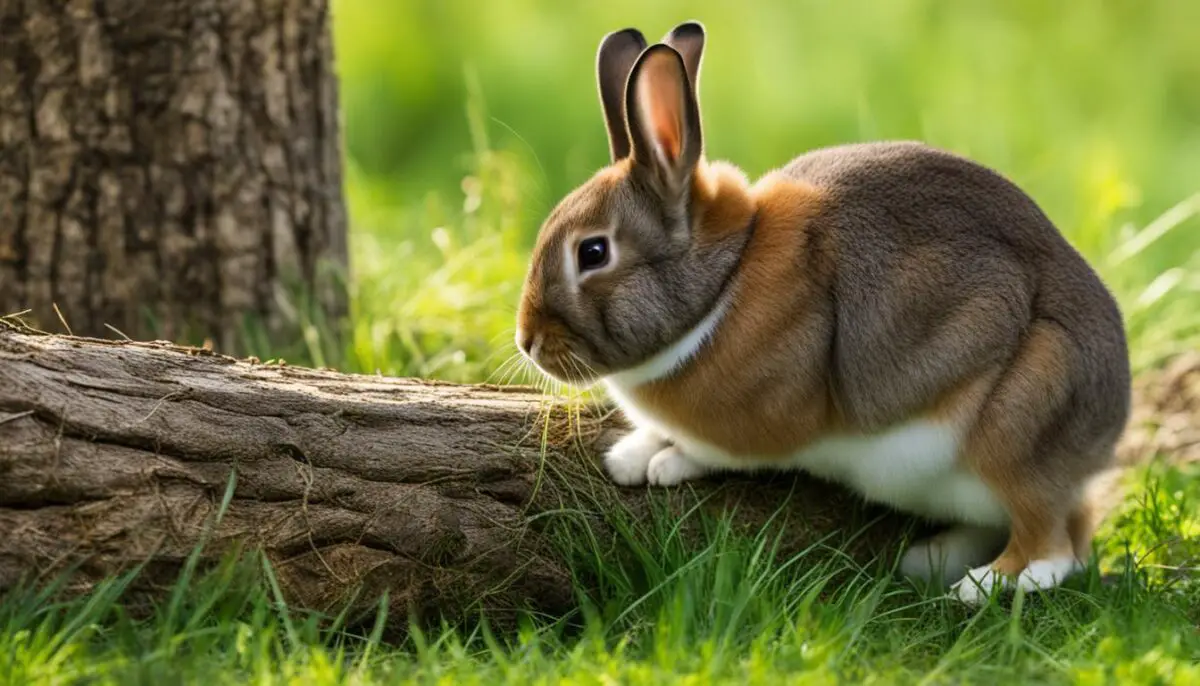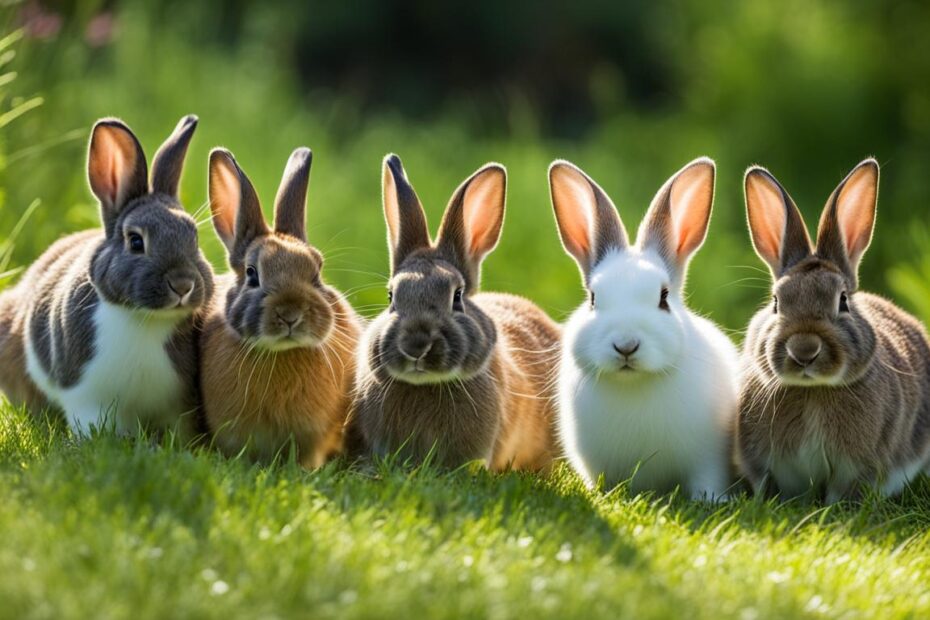Are you considering keeping a pet rabbit outdoors? It’s important to understand that not all rabbit breeds are suitable for outdoor living. Some rabbits thrive in outdoor environments, while others prefer the comfort of indoor living. In this article, we will explore which rabbits can live outside, discuss their specific needs, and provide valuable tips for caring for outdoor rabbits.
Key Takeaways:
- Not all rabbit breeds are suitable for outdoor living.
- Rabbits that can live outside require specific care and housing.
- The best outdoor rabbit breeds include New Zealand White, Checkered Giant, Dutch, French Lop, Belgian Hare, California, Flemish Giant, Rhinelander, and Silver Fox.
- Outdoor rabbit housing should be spacious, secure, and provide shelter from predators.
- Proper diet, hygiene, and enrichment are essential for the well-being of outdoor rabbits.
Which Rabbits Can Live Outside:
The Best Outdoor Rabbit Breeds
When it comes to selecting rabbits that are well-suited for outdoor living, certain breeds stand out. These breeds have characteristics that make them adaptable to outdoor environments, ensuring their comfort and well-being. Whether you’re considering getting a rabbit for your backyard or are interested in expanding your existing outdoor rabbit family, here are some of the best outdoor rabbit breeds to consider:
New Zealand White Rabbit
The New Zealand White Rabbit is known for its resilience and adaptability. This breed has a thick, white coat that provides insulation during colder months and protects from the sun in warmer climates. They are also known for their docile temperament, making them a great choice for families.rabbits suitable for outdoor living
Checkered Giant Rabbit
The Checkered Giant Rabbit is a large breed that thrives in outdoor environments. It has a striking black and white pattern on its fur, making it visually appealing. With their strong and muscular bodies, Checkered Giants are well-suited for roaming and exploring outdoor spaces.rabbits that can live in outdoor hutches
Dutch Rabbit
The Dutch Rabbit is a compact and active breed that can adapt well to outdoor living. They are known for their distinctive markings, with a white body and colored patches on their head, back, and feet. Dutch Rabbits are energetic and enjoy hopping around, making them a delight to watch in outdoor settings.
French Lop Rabbit
The French Lop Rabbit is a larger breed with a playful and friendly nature. They have long ears that give them a distinctive appearance. French Lops thrive in outdoor environments where they have plenty of space to explore and play.outdoor rabbit care tips
Belgian Hare Rabbit
The Belgian Hare Rabbit is an active and agile breed that is well-suited for outdoor living. They have a sleek and slender body, resembling a hare, and are known for their athletic abilities. Belgian Hares enjoy outdoor activities like running and jumping.outdoor rabbit diet
California Rabbit
The California Rabbit is a breed known for its gentle disposition and adaptability to outdoor environments. They have a medium-sized body with a white coat and colored points on their nose, ears, and feet. California Rabbits are hardy and can thrive in various climates.
Flemish Giant Rabbit
The Flemish Giant Rabbit is one of the largest domestic rabbit breeds. They have a calm and friendly temperament, making them suitable for outdoor living. With their large size and thick coat, Flemish Giants can handle colder climates.
Rhinelander Rabbit
The Rhinelander Rabbit is a breed known for its distinctive markings and playful nature. They have a compact and muscular body with unique patterns on their fur. Rhinelanders enjoy outdoor activities and require space to roam and explore.
Silver Fox Rabbit
The Silver Fox Rabbit is a breed with a striking appearance and a docile temperament. They have a dense fur coat that provides insulation in colder weather. Silver Fox Rabbits thrive in outdoor environments where they have room to hop and play.
These are just a few examples of outdoor rabbit breeds that can bring joy and companionship to your outdoor space. Remember to consider their specific needs, provide appropriate housing and care, and create a safe and enriching environment for them to thrive.choosing outdoor rabbits
Housing Solutions for Outdoor Rabbits
Providing appropriate housing is essential for outdoor rabbits. Outdoor rabbit hutches should be spacious and secure, allowing rabbits to move around, stretch, and engage in natural behaviors. The hutch should have a sheltered area for resting and sleeping, protection from predators, and adequate ventilation to prevent dampness and overheating. Additionally, outdoor rabbits should have access to an exercise run or a fenced-in area where they can hop, run, and play.
A well-designed outdoor rabbit hutch should prioritize the safety and comfort of the rabbits. It should be constructed with durable materials that can withstand various weather conditions. The hutch should have solid walls and a sturdy roof to protect rabbits from predators like foxes, cats, and birds of prey. The floor of the hutch should be solid to prevent injuries and allow for easy cleaning.
When it comes to ventilation, the hutch should have openings or mesh panels that allow for proper airflow. This ensures that the hutch remains well-ventilated and prevents the accumulation of moisture and odors. It is important to note that while ventilation is necessary, drafts should be avoided as they can cause discomfort and health issues for the rabbits.
Table: Comparison of Outdoor Rabbit Housing Options
| Housing Option | Advantages | Disadvantages |
|---|---|---|
| Rabbit Hutch | – Provides shelter and protection from predators – Allows for separate sleeping and exercise areas – Easy to clean and maintain |
– May require additional fencing or enclosures for exercise – Limited space for rabbits to move around |
| Outdoor Enclosures | – Provides larger space for rabbits to exercise – Allows for a more natural environment – Can be customized and expanded |
– Requires secure fencing to prevent escapes – May be more challenging to clean and maintain |
| Combination of Hutch and Enclosure | – Provides the benefits of both options – Allows for flexibility in housing arrangements – Provides ample space for rabbits to move and exercise |
– Requires more space and setup – Requires additional planning and design |
It is important to regularly inspect and maintain the outdoor rabbit housing to ensure that it remains safe and comfortable for the rabbits. This includes checking for any signs of damage, repairing or replacing worn-out parts, and cleaning the hutch and exercise area regularly. By providing suitable housing solutions, outdoor rabbits can thrive and lead healthy and fulfilling lives in an outdoor environment.
Outdoor Rabbit Care Tips
To ensure the well-being of outdoor rabbits, proper care and attention are essential. Here are some tips to help you provide the best care for your outdoor rabbits:
Diet:
A balanced diet is crucial for the health of outdoor rabbits. They should have access to unlimited amounts of fresh hay, which aids in digestion and wears down their teeth. Supplement their diet with a variety of fresh greens, such as parsley, spinach, and dandelion greens. Additionally, provide a limited amount of high-quality rabbit pellets to ensure they receive all the necessary nutrients.
Water:
Outdoor rabbits must have access to clean and fresh water at all times, especially during hot weather. Make sure their water containers are kept in shaded areas to prevent overheating or algae growth. Regularly check and refill their water supply to ensure they stay hydrated.
Grooming:
Regular grooming is essential for outdoor rabbits to maintain healthy fur and skin. Check their coats for any signs of matted fur, parasites, or skin issues. Trim their nails regularly to prevent overgrowth and discomfort. If you notice any abnormalities or signs of illness, consult a veterinarian for proper diagnosis and treatment.
Health Monitoring:
Monitor your outdoor rabbits’ health closely and look for any signs of illness or injury. Keep an eye out for changes in behavior, appetite, or bathroom habits. Seek veterinary care if you notice any significant changes or if your rabbit shows signs of distress. Regular veterinary check-ups are also recommended to ensure their overall well-being.
Creating a Safe Outdoor Environment
When keeping rabbits outdoors, it is essential to create a safe environment to protect them from potential predators. Outdoor rabbits are vulnerable to various predators such as dogs, cats, foxes, rats, and birds of prey. Taking necessary precautions will ensure the safety and well-being of your outdoor rabbits.
To protect your outdoor rabbits from predators, it is important to ensure that their enclosure is secure. Use sturdy fencing that is dug into the ground to prevent predators from digging under it. Cover the enclosure with wire mesh to prevent access from above. Regularly inspect the enclosure for any potential weak spots or gaps that predators may exploit.
In addition to providing a secure enclosure, consider adding hiding places for your rabbits. Boxes or tunnels within the enclosure will give them a safe place to escape if they feel threatened. These hiding spots can also provide enrichment and mimic their natural instincts.

Extreme weather conditions can also pose a risk to outdoor rabbits. Provide shade and shelter from wind, cold, rain, and excessive heat. During hot weather, ensure that your rabbits have access to cool areas and fresh water to prevent heat stress. In colder months, insulate the hutch and protect it from drafts to keep your rabbits warm.
By creating a safe outdoor environment for your rabbits, you can give them the freedom to enjoy their natural instincts while ensuring their safety and well-being.
Ventilation and Temperature Considerations
Proper ventilation and temperature control are crucial for creating a healthy and comfortable outdoor environment for rabbits. Good ventilation helps prevent the build-up of moisture and odors, ensuring a fresh and clean living space. It also aids in regulating the temperature within the enclosure, keeping rabbits safe from extreme heat or cold.
When designing an outdoor rabbit hutch, consider incorporating ventilation openings or mesh panels to promote air circulation. These openings should be strategically placed to prevent drafts or direct exposure to wind. Additionally, ensure that the hutch is well-insulated during colder months to protect rabbits from the chill.
During hot weather, it’s essential to provide shade and ventilation to prevent heat stress. Consider adding a removable cover or awning to provide shelter from direct sunlight. This will help keep the temperature inside the hutch cooler. Position the hutch in a shaded area, away from direct sunlight, and make sure there is enough airflow to prevent overheating.
“Proper ventilation and temperature control are crucial for creating a healthy and comfortable outdoor environment for rabbits.”
| Ventilation Tips | Temperature Tips |
|---|---|
|
|
Monitoring the temperature inside the hutch is crucial. Use a thermometer to regularly check the temperature within the enclosure, ensuring it stays within a comfortable range for rabbits. Extreme temperatures can be detrimental to their health, so it’s important to take necessary precautions and provide suitable shelter to mitigate any potential risks.
Bedding and Hygiene for Outdoor Rabbits
Ensuring proper bedding and hygiene for outdoor rabbits is essential for their comfort, health, and overall well-being. The right bedding materials provide a soft and cozy surface for rabbits to rest on while also helping to maintain cleanliness in their enclosure. Hay and straw are commonly used bedding options that not only offer comfort but also serve as a source of enrichment for rabbits, allowing them to forage and engage in natural behaviors.
Regular cleaning of the hutch and exercise area is crucial to prevent the build-up of waste and maintain a hygienic environment. Wet or soiled bedding should be promptly removed and replaced with fresh bedding to prevent odor and bacterial growth. It is important to use pet-friendly disinfectants during cleaning to ensure the safety of the rabbits. Additionally, water and food containers should be cleaned regularly to prevent contamination.
Proper hygiene practices also include regular grooming of outdoor rabbits. This involves brushing their fur to remove dirt and loose hair, as well as checking for any signs of fleas, ticks, or skin irritations. Regular nail trims are necessary to prevent overgrowth and discomfort. It is important to handle rabbits with care and ensure they feel secure during grooming sessions.
| Bedding and Hygiene Tips for Outdoor Rabbits |
|---|
| Choose hay or straw as bedding material for comfort and enrichment. |
| Regularly clean the hutch and exercise area to maintain hygiene. |
| Replace wet or soiled bedding promptly to prevent odor and bacteria build-up. |
| Use pet-friendly disinfectants for cleaning to ensure safety. |
| Regularly groom rabbits by brushing their fur and trimming their nails. |
| Check for signs of fleas, ticks, or skin irritations during grooming. |
Creating a clean and comfortable living environment for outdoor rabbits is crucial for their overall health and well-being. By providing suitable bedding materials, regularly cleaning their enclosure, and maintaining proper grooming practices, you can ensure that your outdoor rabbits are happy and thriving.

Tips for Choosing Bedding:
- Opt for hay or straw as bedding materials, as they provide comfort and enrichment for rabbits.
- Avoid using cedar or pine shavings, as these can be harmful to rabbits’ respiratory systems.
- Ensure the bedding is clean, dry, and free from contaminants.
- Monitor your rabbits’ preferences and adjust the bedding as needed to cater to their comfort.
“Proper bedding and hygiene practices are essential for maintaining the health and happiness of outdoor rabbits. By providing clean, comfortable bedding and regularly cleaning their enclosure, you can ensure that your rabbits have a safe and hygienic living environment.”
Providing Enrichment and Play for Outdoor Rabbits
Outdoor rabbits thrive when they have plenty of mental and physical stimulation. Providing enrichment and play opportunities is essential for their overall well-being and happiness. By incorporating various interactive elements into their environment, you can keep your outdoor rabbits engaged, active, and entertained.
Outdoor Rabbit Enrichment: There are several ways to enrich the lives of outdoor rabbits. One option is to provide tunnels and burrows for them to explore and hide in. You can create these using PVC pipes or cardboard tubes. Another option is to offer gnawing toys made from pet-safe materials like untreated wood or apple sticks. These toys not only provide entertainment but also help rabbits keep their teeth healthy and trimmed.
“Enrichment is an essential part of rabbit care, as it encourages natural behaviors and helps prevent boredom and stress.”
Outdoor Rabbit Play: Outdoor rabbits need space to play and exercise. Consider providing a large exercise area where they can hop, run, and explore. You can create an outdoor playpen using portable fencing or use an enclosed yard. Adding natural elements, such as rocks, logs, and branches, can further enhance their play area, offering different textures and surfaces to explore. Remember to supervise outdoor playtime to ensure their safety and protect them from potential predators.
Outdoor Rabbit Toys: Toys are a great way to keep outdoor rabbits mentally stimulated. Puzzle toys, treat balls, and foraging toys can engage their natural instincts by encouraging them to search for food or solve puzzles to access treats. You can also create DIY toys using cardboard boxes filled with hay or shredded paper, providing them with objects to explore and play with.
Making Playtime Safe and Fun
While providing enrichment and play for outdoor rabbits is important, it’s equally crucial to ensure their safety during playtime. Ensure the play area is secure, with no potential escape routes or openings that predators could exploit. Remove any toxic plants or substances from their play area, and check toys regularly for signs of wear and tear to prevent injury. Supervision is key, allowing you to intervene if any potential hazards or conflicts arise.
By incorporating enrichment activities, playtime, and appropriate toys into your outdoor rabbits’ routine, you can enhance their quality of life and support their natural instincts. Remember to observe their preferences and tailor the activities to their needs. The happiness and well-being of your outdoor rabbits are worth the effort!

| Benefits of Outdoor Rabbit Enrichment | Enrichment Ideas |
|---|---|
| 1. Prevents boredom and stress | 1. Provide tunnels and hiding spots |
| 2. Encourages natural behaviors | 2. Offer gnawing toys |
| 3. Stimulates mental and physical activity | 3. Create a large exercise area |
| 4. Supports dental health | 4. Use puzzle toys and treat balls |
| 5. DIY toys with cardboard boxes |
Conclusion
In conclusion, providing a suitable outdoor environment for rabbits is essential for their well-being and happiness. By considering the specific needs of outdoor rabbit breeds, providing appropriate housing, and ensuring their care and safety, you can create a thriving outdoor setting for your rabbits.
Remember to select rabbit breeds known for their adaptability to outdoor living, such as the New Zealand White Rabbit, Checkered Giant Rabbit, and Dutch Rabbit. These breeds have the characteristics necessary to thrive in outdoor environments.
Additionally, it is crucial to provide adequate shelter, proper ventilation, and protection from predators. Regular care, including a balanced diet, grooming, and monitoring their health, is essential for their overall well-being.
By following these guidelines and consulting a veterinarian when needed, you can create a safe and enriching outdoor environment for your rabbits. Outdoor rabbits will have the opportunity to express their natural instincts, live happily, and enjoy their surroundings to the fullest.
FAQ
Which rabbit breeds are best suited for living outside?
The best outdoor rabbit breeds include the New Zealand White Rabbit, Checkered Giant Rabbit, Dutch Rabbit, French Lop Rabbit, Belgian Hare Rabbit, California Rabbit, Flemish Giant Rabbit, Rhinelander Rabbit, and Silver Fox Rabbit.
What are the breed-specific requirements of outdoor rabbits?
Outdoor rabbits need spacious and secure housing with sheltered areas, protection from predators, and adequate ventilation. They also require access to an exercise run or a fenced-in area.
How should I care for outdoor rabbits?
Outdoor rabbits should be provided with a balanced diet, regular grooming, access to fresh water, and monitoring of their health. Consult a veterinarian if any signs of illness or injury are observed.
How can I create a safe environment for outdoor rabbits?
To protect outdoor rabbits, ensure their enclosure is secure with appropriate fencing and covers. Provide hiding places and protection from extreme weather conditions.
What considerations should I have for ventilation and temperature control for outdoor rabbit housing?
Outdoor rabbit housing should be well-ventilated to prevent moisture build-up. In colder weather, insulate the hutch and protect it from drafts. In hot weather, provide shade and ventilation to prevent heat stress.
What bedding and hygiene practices are important for outdoor rabbits?
Outdoor rabbits should have clean and dry bedding, such as hay and straw. Regular cleaning of the hutch and exercise area is necessary, along with replacing wet or dirty bedding and cleaning food and water containers.
How can I provide enrichment and play for outdoor rabbits?
Outdoor rabbits should have access to tunnels, chew toys, and digging boxes for mental stimulation. They also need a spacious exercise area where they can hop, run, and explore.
What are some additional tips for outdoor rabbit care?
Remember to consider breed-specific needs, provide regular care and attention, and consult a veterinarian for any concerns. With the right care, outdoor rabbits can thrive and enjoy their natural instincts in an outdoor setting.


